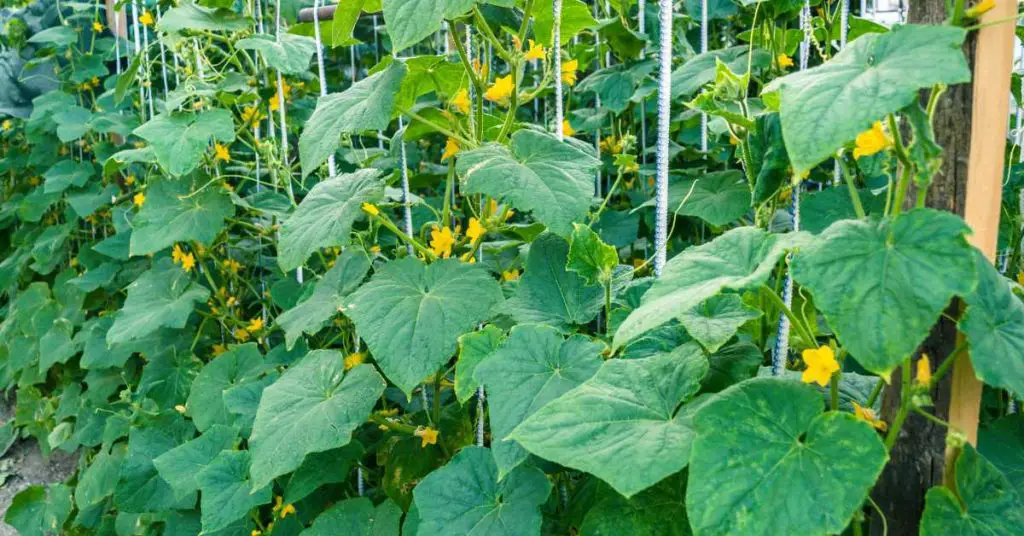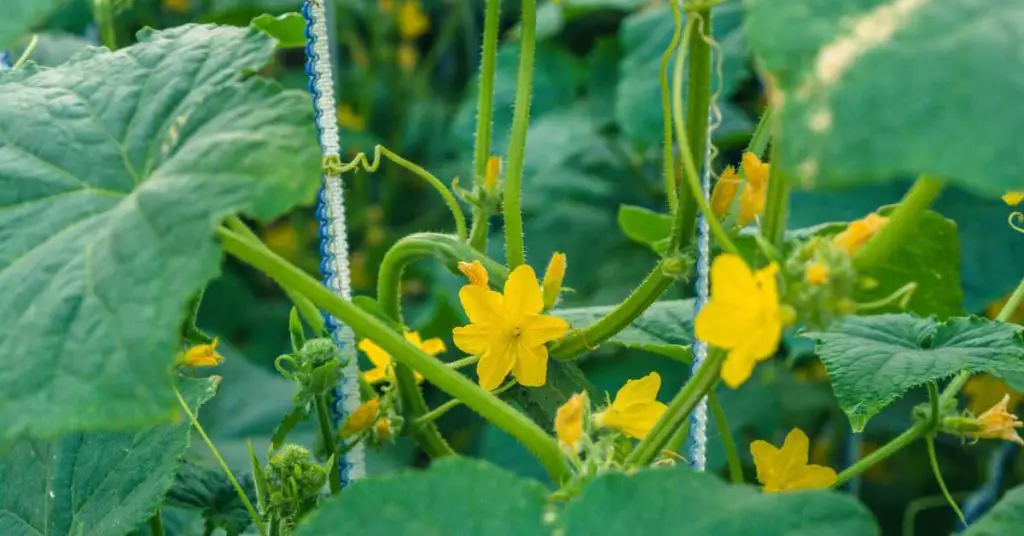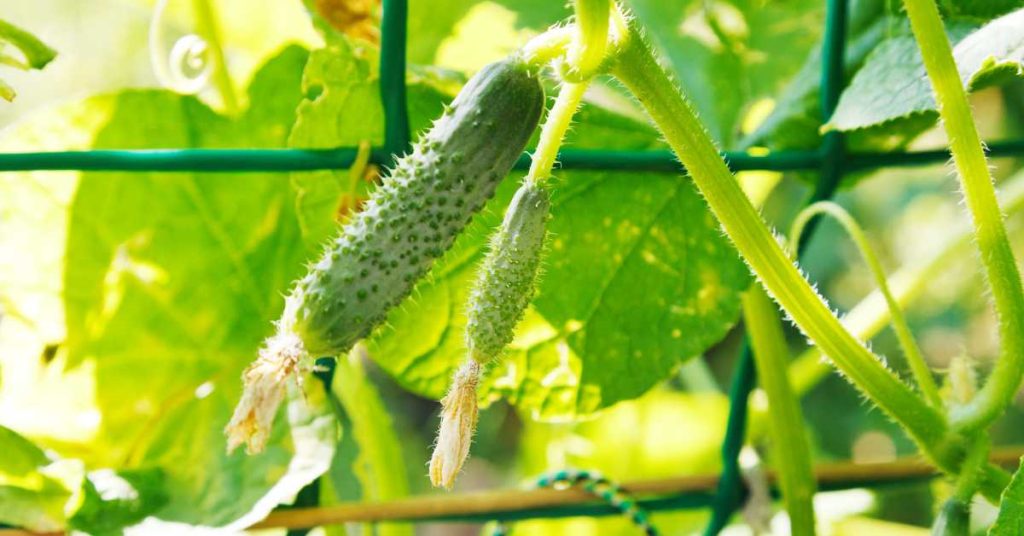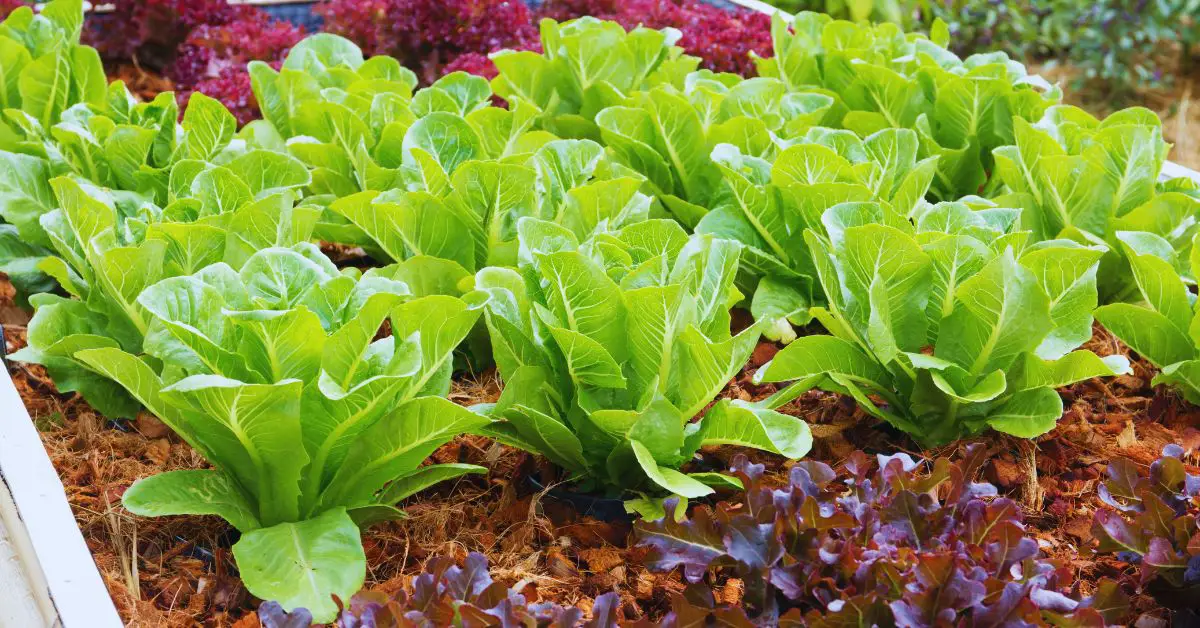Growing cucumbers in grow bags is a great way to enjoy fresh cucumbers, even if you don’t have much space. Grow bags are versatile and can be placed anywhere—on a balcony, patio, or small garden area.
They are perfect for urban gardeners or anyone with limited space. Using grow bags offers many benefits, such as improved drainage and air circulation for the roots.
Cucumbers are easy to grow and can produce a bountiful harvest. With a few simple steps, you can start growing your own cucumbers at home.
This guide will help you understand how to choose the right grow bag, prepare it, and care for your cucumber plants. Let’s get started on your cucumber-growing journey!

Choosing the Right Grow Bag
Size and Material: It’s important to choose the right size grow bag for your cucumbers. A grow bag that is 15-20 gallons is ideal. This size gives the cucumber plants enough room for their roots to grow and spread out.
Look for grow bags made of durable, breathable materials. Fabric grow bags are a great choice because they allow air to reach the roots, which helps the plants grow better.
Drainage: One of the best things about fabric grow bags is that they are porous. This means they naturally provide good drainage. You don’t need to worry about adding drainage holes. The fabric allows excess water to escape, preventing the roots from sitting in water and rotting.
Choosing the right grow bag sets the foundation for healthy cucumber plants. Make sure to select a sturdy and breathable bag to give your plants the best start.
Selecting the Best Cucumber Varieties
Bush Varieties
When growing cucumbers in grow bags, bush varieties are an excellent choice. Bush cucumbers are more compact and don’t require much space to spread out. Some good bush varieties include ‘Spacemaster’ and ‘Bush Champion’. These varieties are perfect for small spaces and are easy to manage.
Vining Varieties
If you prefer vining cucumbers, you can still grow them in grow bags. Vining cucumbers need support to grow upwards. This can be done using trellises or stakes. Some popular vining varieties include ‘Marketmore’ and ‘Straight Eight’.

Choosing the Right Variety
Consider your space and the type of cucumber you like to eat. Bush varieties are great for small areas, while vining varieties can give you a larger harvest if you have room for a trellis.
Picking the right cucumber variety is key to a successful grow bag garden. Make sure to choose the variety that best suits your space and needs.
Can You Grow A Super Vigorous Cucumber Variety In A Grow Bag?
Yes, you can grow a super vigorous cucumber variety in a grow bag, but it requires extra care and attention. Super vigorous cucumber varieties tend to have extensive root systems and long vines. To accommodate their growth, choose a large grow bag, ideally 20 gallons or more, to provide ample space for the roots.
Supporting the vines is crucial. Use a sturdy trellis or support structure to train the vines upwards. This not only saves space but also improves air circulation and reduces the risk of diseases.
Regular feeding is essential for vigorous varieties. Use a balanced fertilizer and follow a consistent feeding schedule to ensure the plants get enough nutrients. Keep the soil consistently moist but not waterlogged, as these varieties can be sensitive to both under- and over-watering.
With the right grow bag, proper support, and diligent care, you can successfully grow a super vigorous cucumber variety in a grow bag.
Preparing the Grow Bag
Soil Mix
The right soil mix is essential for healthy cucumber plants. Use a high-quality potting mix combined with compost. This mix provides the necessary nutrients and ensures good drainage. Adding perlite or vermiculite can improve soil aeration, helping the roots get enough oxygen.
Fertilization
Start by mixing a slow-release fertilizer into the soil before planting. This gives the plants a steady supply of nutrients as they grow. Follow the package instructions for the right amount to use.
Filling the Grow Bag
Fill the grow bag with the prepared soil mix, leaving about 2-3 inches from the top. This space helps prevent soil and water from spilling over when watering.
Pre-Watering
Before planting, water the soil thoroughly. Moist soil helps the young plants settle in more easily. Let the water drain out to ensure the soil is evenly moist but not soggy.
Preparing the grow bag properly sets the stage for healthy cucumber growth. Taking these steps ensures your plants have the best start possible.
Planting the Cucumbers
Starting Seeds vs. Transplants
You have two options for planting cucumbers: starting from seeds or using transplants. Starting from seeds is cost-effective and allows you to grow more plants. However, it takes longer for the plants to mature. Transplants give you a head start and are ideal if you want to harvest sooner.
Planting Depth and Spacing
If you’re planting seeds, sow them about 1/2 inch deep in the soil. Place 2-3 seeds per hole to ensure at least one germinates. Once they sprout, thin them out to leave the strongest seedling. For transplants, dig a hole large enough to accommodate the root ball and plant at the same depth as in the pot.
Spacing
Proper spacing is crucial for healthy growth. For bush varieties, leave about 18-24 inches between plants. For vining varieties, you can plant them closer together if you are using a trellis, about 12-18 inches apart. This spacing allows each plant enough room to grow and receive adequate sunlight.
Watering After Planting
After planting, water the plants gently but thoroughly. This helps settle the soil around the roots and provides moisture for the plants to establish themselves. Keep the soil consistently moist during the germination and early growth stages.
By carefully planting your cucumbers and giving them the right start, you set the foundation for a healthy and productive crop.
Watering Requirements
Consistency
Cucumber plants need consistent watering to thrive. Keep the soil evenly moist but not soggy. Inconsistent watering can lead to bitter cucumbers and poor growth. Check the soil regularly, especially during hot weather, to ensure it doesn’t dry out.
Frequency
Water cucumbers in grow bags 2-3 times per week, or whenever the top inch of soil feels dry. During hot and dry periods, you may need to water more frequently. Early morning is the best time to water, as it allows the plants to absorb moisture before the heat of the day.
Avoid Overwatering
Overwatering can be just as harmful as underwatering. Too much water can cause root rot and other fungal diseases. Ensure the grow bag allows excess water to drain out. If the soil feels soggy or if there’s standing water at the bottom of the bag, reduce the frequency of watering.
Signs of Water Stress
Be aware of the signs of water stress. Wilted leaves can indicate both underwatering and overwatering. Yellowing leaves might suggest overwatering, while dry, crispy leaves are a sign of underwatering. Adjust your watering schedule accordingly to keep your cucumber plants healthy.
Proper watering is essential for growing cucumbers in grow bags. By maintaining consistent moisture levels, you ensure your plants stay healthy and productive.
Providing Support for Vining Cucumbers
Trellises and Supports
Vining cucumber varieties need support to grow properly. Using a trellis or stakes helps the vines grow vertically. This not only saves space but also improves air circulation around the plants, reducing the risk of disease. You can use a simple wooden trellis, metal stakes, or even a sturdy fence.
Setting Up the Support
Place the trellis or stakes in the grow bag at the time of planting. Insert the support deep enough to stay stable as the plants grow. For a trellis, position it at the back of the grow bag to allow the vines to climb naturally. Make sure the support is tall enough to accommodate the full growth of the cucumber vines.
Training the Vines
As the cucumber plants grow, gently guide the vines towards the trellis or stakes. Use soft ties or garden clips to secure the vines to the support. Be careful not to tie them too tightly, as this can damage the plants. Check the vines regularly and continue to train them as they grow taller.
Benefits of Vertical Growing
Growing cucumbers vertically has several benefits. It keeps the fruits off the ground, reducing the chances of rot and pest damage. It also makes harvesting easier and more efficient. Additionally, vertical growth allows for better sunlight exposure, which is crucial for healthy fruit development.
By providing proper support for vining cucumbers, you ensure that your plants grow strong and healthy, leading to a bountiful harvest.

Mulching and Weed Control
Benefits of Mulching
Mulching is a simple but effective way to keep your cucumber plants healthy. Mulch helps retain moisture in the soil, reducing the need for frequent watering. It also helps regulate soil temperature, keeping the roots cool in hot weather. Additionally, mulch prevents soil from splashing onto the leaves, which can spread diseases.
Types of Mulch
There are several types of mulch you can use. Organic mulches, like straw, wood chips, or grass clippings, are great choices. They decompose over time, adding nutrients to the soil. Straw is particularly effective as it is lightweight and easy to spread. Avoid using fresh grass clippings or leaves that might mat down and prevent water from reaching the soil.
Applying Mulch
Apply a 2-3 inch layer of mulch around the base of your cucumber plants. Make sure to leave a small gap around the stem to prevent rot. Spread the mulch evenly to cover the soil surface. Replenish the mulch layer as needed, especially after heavy rains or strong winds.
Weed Control
Mulch also helps in controlling weeds. A thick layer of mulch blocks sunlight, preventing weed seeds from germinating. This reduces competition for water and nutrients, allowing your cucumber plants to grow better. If you notice any weeds poking through the mulch, remove them promptly to keep the area clean.
Using mulch in your grow bags provides multiple benefits. It keeps the soil moist, controls weeds, and improves overall plant health. This simple step can make a big difference in the success of your cucumber plants.
Monitoring for Pests and Diseases
Common Pests
Cucumber plants can attract various pests. Cucumber beetles, aphids, and spider mites are some of the most common. These pests can damage leaves, stems, and fruits, leading to reduced yields. Regularly inspect your plants for signs of pests, such as holes in leaves, sticky residue, or visible insects.
Managing Pests
If you notice pests on your cucumber plants, take action immediately. Hand-pick visible pests off the plants and dispose of them. For severe infestations, you can use insecticidal soap or neem oil. Apply these treatments according to the instructions on the label. Introducing beneficial insects, like ladybugs, can also help control pest populations naturally.
Common Diseases
Cucumbers are susceptible to diseases such as powdery mildew, downy mildew, and bacterial wilt. Look for signs like white powdery spots, yellowing leaves, or wilting vines. Early detection is crucial to prevent the spread of these diseases.
Disease Prevention
To prevent diseases, practice good garden hygiene. Water the plants at the base to avoid wetting the leaves. Wet leaves are more prone to fungal infections. Ensure good air circulation around the plants by spacing them properly and using supports for vining varieties. Remove any diseased leaves or plants promptly to prevent the spread of infections.
Regular Monitoring
Regularly check your cucumber plants for any signs of stress, pests, or diseases. Early intervention is key. The sooner you address any issues, the better your chances of maintaining healthy plants. Keep a close eye on your plants, especially during periods of high humidity or after heavy rains.
By staying vigilant and taking proactive measures, you can effectively manage pests and diseases, ensuring a healthy and productive cucumber harvest.
Harvesting Cucumbers
When to Harvest
Knowing when to harvest cucumbers is crucial for getting the best flavor and texture. Cucumbers are usually ready to harvest when they reach their mature size and color. For most varieties, this means about 6-8 inches long for slicing cucumbers and 3-4 inches long for pickling varieties. The skin should be firm and smooth, and the color should be bright green. Overripe cucumbers can become yellow and bitter.
Harvesting Techniques
To harvest cucumbers, use a sharp knife or garden shears. Cut the cucumber from the vine, leaving a small piece of stem attached. This helps prevent damage to the vine and reduces the risk of disease entry. Avoid twisting or pulling the cucumbers off the vine, as this can harm the plant.
Frequency of Harvesting
Cucumbers grow quickly, especially in warm weather. Check your plants daily for new cucumbers. Harvesting frequently encourages the plant to produce more fruits. If you leave cucumbers on the vine too long, it signals the plant to slow down production.
Post-Harvest Handling
After harvesting, rinse the cucumbers with cool water to remove any dirt or pests. Store them in the refrigerator to keep them fresh. Cucumbers are best used within a few days of harvesting for the best flavor and texture.
By harvesting your cucumbers at the right time and using proper techniques, you can enjoy a continuous supply of fresh and delicious cucumbers throughout the growing season.

What Size Grow Bag Is Best for Cucumbers?
A 15-20 gallon grow bag is ideal for growing cucumbers. This size provides enough space for the roots to expand and allows the plants to grow vigorously. Smaller grow bags can restrict root growth, leading to smaller plants and reduced yields. Using a larger grow bag ensures your cucumbers have the room they need to thrive and produce a bountiful harvest.
How Often Should I Water Cucumbers in Grow Bags?
Water cucumbers in grow bags 2-3 times per week. The key is to keep the soil consistently moist but not soggy. During hot and dry periods, you may need to water more frequently. Check the soil regularly by sticking your finger an inch deep into it. If it feels dry, it’s time to water. Always water the plants thoroughly, ensuring the water reaches the roots.
Can I Grow Cucumbers in a Small Apartment Balcony?
Yes, you can grow cucumbers in a small apartment balcony. Grow bags are perfect for limited spaces because they can be placed anywhere there’s enough sunlight. Choose compact bush varieties or use trellises to grow vining cucumbers vertically. Ensure your balcony receives at least 6-8 hours of sunlight daily, and follow proper watering and care routines to keep your plants healthy.
What Is the Best Fertilizer for Cucumbers in Grow Bags?
A balanced fertilizer with equal parts nitrogen, phosphorus, and potassium (e.g., 10-10-10) works well for cucumbers. Apply the fertilizer according to the package instructions, usually every 2-3 weeks. You can also use organic options like compost or fish emulsion. Regular feeding ensures that the plants get the necessary nutrients to grow and produce a good yield.
Do I Need to Hand-Pollinate Cucumbers Grown in Grow Bags?
Hand-pollination is usually not necessary if your cucumbers are outdoors where bees and other pollinators can access them. However, if grown indoors or in an area with few pollinators, you may need to hand-pollinate. Use a small brush or cotton swab to transfer pollen from male flowers to female flowers. This helps ensure successful fruit set and a good harvest.
Frequently Asked Questions (FAQs)
What Size Grow Bag Is Best for Cucumbers?
A 15-20 gallon grow bag is best for cucumbers. This size allows plenty of room for the roots to grow and helps the plants develop properly. Smaller bags can restrict root growth, leading to smaller plants and fewer cucumbers.
How Often Should I Water Cucumbers in Grow Bags?
You should water cucumbers in grow bags 2-3 times per week. The key is to keep the soil consistently moist. During hot weather, you might need to water more often. Check the soil regularly to make sure it doesn’t dry out.
Can I Grow Cucumbers in a Small Apartment Balcony?
Yes, you can grow cucumbers on a small apartment balcony. Grow bags are perfect for small spaces because they can be placed anywhere. Choose bush varieties or use trellises to grow vining cucumbers vertically. Make sure your balcony gets enough sunlight, about 6-8 hours a day.
What Is the Best Fertilizer for Cucumbers in Grow Bags?
A balanced fertilizer, such as 10-10-10, is best for cucumbers in grow bags. This type of fertilizer provides equal parts of nitrogen, phosphorus, and potassium, which are essential for growth. Apply the fertilizer according to the instructions, usually every 2-3 weeks.
Do I Need to Hand-Pollinate Cucumbers Grown in Grow Bags?
Hand-pollination is usually not needed if your cucumbers are outdoors, where bees can reach them. However, if you are growing them indoors or in an area with few pollinators, you might need to hand-pollinate. Use a small brush to transfer pollen from male flowers to female flowers to ensure good fruit set.
Conclusion
Growing cucumbers in grow bags is a simple and rewarding way to enjoy fresh cucumbers at home. With the right care and attention, you can successfully grow healthy and productive cucumber plants.
Remember to choose the right grow bag, prepare it properly, and select the best cucumber varieties. Consistent watering, providing support, and monitoring for pests and diseases are crucial.
Harvest your cucumbers at the right time to enjoy their best flavor. By following these steps, you’ll be well on your way to a bountiful cucumber harvest.
Start your grow bag gardening today and enjoy the benefits of homegrown cucumbers. Happy gardening!





